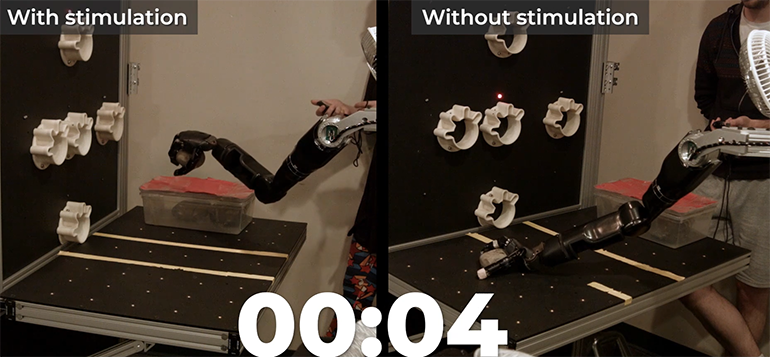
Researchers at the University of Pittsburgh have demonstrated that providing direct sensory feedback into the brain dramatically enhanced an impaired patient’s control of a robotic arm. The arm was operated through a brain-computer interface, but the system also included brain implants in an area of the brain responsible for sensory feedback. When the patient completed tasks using the arm, he was significantly faster when sensory feedback was enabled, mimicking the way someone can feel an object they are gripping with their hand. The technique could make brain-computer interface systems easier and more intuitive to use, and therefore practical.
Brain-computer interfaces are poised to transform life for amputees and people without full motor or sensory control of their limbs. From wheelchairs to robotic prostheses, the opportunities are enormous. However, using a limb is difficult if you can’t feel the objects you are interacting with. Imagine trying to perform a simple task if your arm is completely numb.
To address this, this latest brain-computer interface includes sensory feedback in the form of brain implants in the somatosensory cortex, allowing the user to receive sensory tactile feedback while operating a robotic arm. The system also includes implants in the motor cortex, which allow the user to control the arm.
The first and only user of the system, Nathan Copeland, is the first patient in the world to receive such sensory implants. Following a road traffic accident, Copeland has limited use of his arms, and volunteered to have the implants inserted as part of a clinical trial.
In this recent study, Copeland used the robotic arm to complete various tasks, and the researchers compared the time it took with and without sensory feedback. The results show that Copeland completed the tasks in almost half the time when sensory feedback was activated (approximately 10 seconds per task, compared to 20 seconds without sensory feedback).
Here’s a quick example of Mr. Copeland performing the same task with and without the novel stimulation:
“In a sense, this is what we hoped would happen – but perhaps not to the degree that we observed,” said Jennifer Collinger, a researcher involved in the study, in a press release. “Sensory feedback from limbs and hands is hugely important for doing normal things in our daily lives, and when that feedback is lacking, people’s performance is impaired.”
The results suggest that developing more advanced sensory feedback systems could significantly enhance brain-computer interface user performance. “When even limited and imperfect sensation is restored, the person’s performance improved in a pretty significant way,” said Robert Gaunt, another researcher involved in the study. “We still have a long way to go in terms of making the sensations more realistic and bringing this technology to people’s homes, but the closer we can get to recreating the normal inputs to the brain, the better off we will be.”
Study in Science: A brain-computer interface that evokes tactile sensations improves robotic arm control
